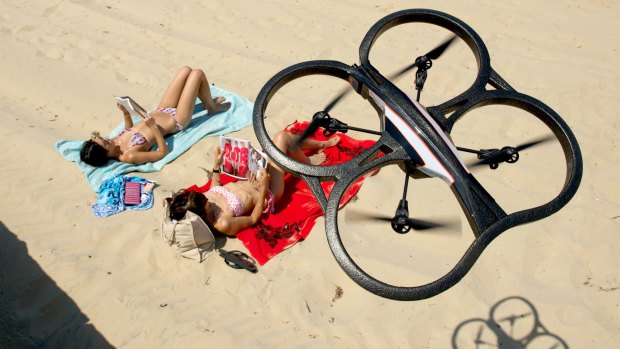This was published 6 years ago
Taking drones on holidays: They're intrusive and annoying
By Michael Gebicki

A remote controlled drone helicopter which can record video and photo's hovers above some sun bathers at Middle Park beach.Credit: Jason South
The hike between Govetts Leap Lookout and Pulpit Rock near the town of Blackheath is one of many sublime bushwalks in the Blue Mountains. The hundred-metre cliffs that ring the valley at your feet bear witness to the ages, striped by sediment bands laid down when this was the bed of a Devonian sea 400 million years ago. The forest tinkles with the far-off sound of bellbirds, but when I get to Pulpit Rock a bunch of kids are flying a drone, sending it up and down the cliffs and 100 metres into the sky. It hums like a demonic wasp, it blinks, it soars, it swoops, and although it is a mere flea against the vast canvas of the mountains, like a flea it is impossible to ignore.
Drones are cheap as chips. A couple of hundred dollars gets you a drone with an HD camera. Make it four figures and you've got a drone with a stabilised, gimbal-mounted camera capable of shooting 4K video and delivering a live feed from a kilometre away. They're also simple to operate. All you need is a finger and a smartphone app in most cases and you're airborne.
There are plenty of legitimate uses for drones. Real estate photographers, farmers and engineers use them as work tools. Airbus uses drones to check its aircraft for scratches, dents and other fuselage damage. In skilled hands, the footage is incredible. A drone can take you over a surfer scooting through the belly of a pipelining wave or over the lava flow of an erupting volcano.
It's when the amateur videographer takes one travelling that drones are at their most intrusive, and annoying.
Over the past couple of years I've encountered a drone in Venice, ascending beside the bell tower in St Mark's Square, over a beach in Thailand and in remote parts of the Swiss Alps.
On a 2015 trip through the Karakum Desert in Turkmenistan I spent a night camping beside the Darvaza Gas Crater, an oxygen sucking, 90-metre wide, coal-red fire monster that the locals know as the "gateway to hell". It was just before sunset when a posse of Spanish motorcycle riders drew up, with a support vehicle and a drone which followed them as they spent the next hour riding around the crater.
The trail bikes were bad enough but they paled alongside the drone which hovered and blinked in the darkening sky. The video would probably have been fantastic but for the half dozen of us watching from a nearby hill the drone shattered what should have been a weirdly serene experience.
Turkmenistan is a totalitarian regime only fractionally less paranoid than North Korea. Taking out a camera anywhere around the government buildings in Ashgabat, the capital, will attract the instant attention of someone in uniform. There is possibly no law in Turkmenistan that forbids the use of drones. In the same way there is probably no law that prevents you from knocking at the front door of wherever it is that Kim Jong-un calls home. There doesn't need to be. I prayed that the long and intrusive arm of Turkmenistan officialdom might infiltrate even the wastelands of the desert but next morning the Spanish riders departed in a trail of dust with their electronically tethered drone hovering obediently overhead.
It doesn't take too much nous to acknowledge that flying a drone over a city or any other densely populated area has a potential downside and most countries have laws that forbid such activity.
In the past few years a Dutch tourist was fined more than US$3000 for crashing a drone aircraft into a famous hot spring in Yellowstone National Park. An Israeli tourist copped a €400 fine and spent a night in the clink after he was nabbed flying a drone over Paris' Notre Dame. A German tourist faced the wrath of Cambodian officials after he was caught piloting a drone over one of the country's royal palaces, startling the queen mother. Last year a French tourist was busted flying a drone over the Colosseum in Rome and faced a possible fine of €113,000. An American tourist flew a drone over Windsor Castle while the queen was in residence. He got away with a ticking off from the constabulary but you'd have to think if that happened today, post London Bridge, the repercussions might not be quite so benign.
Many national park authorities also restrict the use of drones. Parks Victoria and the NSW National Parks and Wildlife Service both require anyone wishing to fly a drone in a national park to check with the park manager, and to ensure the drone will not annoy park visitors or affect wildlife. In the USA the National Parks Service recently declared all national parks no-drone zones.
Enforcing the law is another matter. Park rangers can't be everywhere, although sometimes nature takes revenge. YouTube has spawned a subset of drone takedown sites featuring eagles, angry apes with big sticks, kangaroos and resentful rams delivering the coup de grace to drones.
Sometimes it's the inexplicable, and you have to wonder whether there are angels who regard drones as an offence against heaven. A couple of years back I was in Greenland with a French TV team who were operating a supersize drone, sending it skittering across icebergs too precarious for human feet and swooping low over a sea full of ice floes. The drone was almost back in their hands when just a couple of metres from our Zodiac it turned on its side and plop - straight into the Arctic Sea.
See also: The 9 dumbest things in tourism history
Sign up for the Traveller newsletter
The latest travel news, tips and inspiration delivered to your inbox. Sign up now.